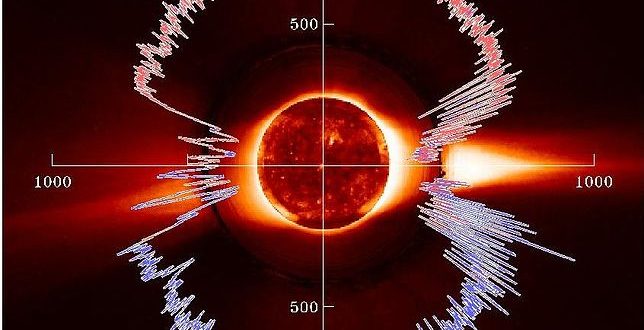What exactly are solar winds?
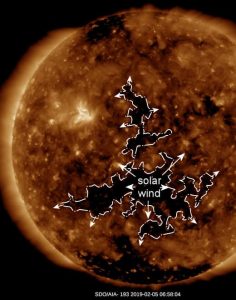
Well to explain we need to know a little about our Sun. The Sun contains magnetic fields that arch away from areas in the corona that are very thin due to the lower levels of energy and gas, which cause coronal holes to appear when they do not fall back. Thus, solar particles escape at a rate great enough to create a lower density and lower temperature in that area.
Coronal holes generally discharge solar winds at a speed about twice the average. The escaping solar wind is known to travel along open magnetic field lines that pass through the coronal hole area. 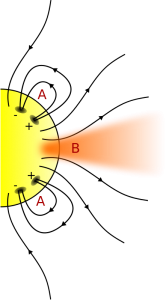
Since coronal holes are regions in the Sun’s corona that have much lower densities and temperatures than most of the corona, these regions are very thin. This thinness contributes to the solar wind since particles within the chromospheres can more easily break through.
The solar wind is a stream of charged particles (a plasma) released from the Sun, when these solar wind structures arrive at Earth they encounter Earth’s magnetic field where solar wind particles are able to enter our atmosphere around our planet’s magnetic north and south pole.
It affects it by the intense clouds of high energy particles that it often contains which are produced by solar storms. When these clouds, called coronal mass ejections, make their way to the Earth in 3-4 days, they collide with the magnetic field of the Earth and cause it to change its shape.
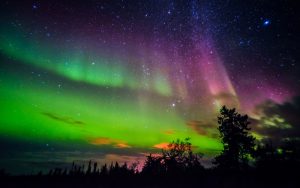
Other related phenomena include the aurora (northern and southern lights), the plasma tails of comet that always point away from the Sun, and geomagnetic storms that can change the direction of magnetic field lines. The solar wind affects other incoming cosmic rays interacting with planetary atmospheres. Moreover, planets with a weak or non-existent magnetosphere are subject to atmospheric stripping by the solar wind.
Venus for example, the nearest and most similar planet to Earth, has 100 times denser atmosphere, with little or no geo-magnetic field. Space probes discovered a comet-like tail that extended to Earth’s orbit.
Earth itself is largely protected from the solar wind by its magnetic field, which deflects most of the charged particles; however some of the charged particles are trapped in the Van Allen radiation belt. A smaller number of particles from the solar wind manage to travel, as though on an electromagnetic energy transmission line, to the Earth’s upper atmosphere and ionosphere in the auroral zones.

The only time the solar wind is observable on the Earth is when it is strong enough to produce phenomena such as the aurora and geomagnetic storms. Bright auroras strongly heat the ionosphere, causing its plasma to expand into the magnetosphere, increasing the size of the plasma geosphere and injecting atmospheric matter into the solar wind. Geomagnetic storms result when the pressure of plasmas contained inside the magnetosphere is sufficiently large to inflate and thereby distort the geomagnetic field.
 The solar activities have been considered to influence the earthquake occurrences and the relation of the two has been studied extensively in the recent years as well as in the past century Aristotle, the Greek philosopher, described that earthquakes occur more frequently during the night than during the day.
The solar activities have been considered to influence the earthquake occurrences and the relation of the two has been studied extensively in the recent years as well as in the past century Aristotle, the Greek philosopher, described that earthquakes occur more frequently during the night than during the day.
Starting at the beginning of the 20th century, studies were performed to determine whether the time sequences of earthquakes follow any systematic pattern. After many studies it became evident that the seismicity exhibits distinct diurnal as well as seasonal cycles in many different earthquake zones. Such cycles of seismic activity can only be attributed to solar influence. Consequently, studies were done to model such solar-terrestrial effects. The powerful electric current vortices in the ionosphere, generated by solar radiation, and the associated magnetic field variations are assumed to be the essential source for the effect. Due to the penetration of those magnetic field variations into the electrically conductive Earth’s lithosphere, and associated electric “telluric” currents, additional mechanical forces are generated in seismic rupture zones. Another observation that supports the theory of solar influence is the clustering of earthquakes in 11-year cycles in accordance with the solar cycles. In this overall context, several recent studies focused on the cycles of the solar polar magnetic field, which manifest themselves in solar flare activity. A high degree of statistical significance was shown for a correlation of those polar field oscillations and the occurrence of strong earthquakes.
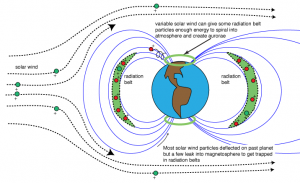
So, the Solar Winds have arrived and are flowing from the indicated negative polarity coronal hole has arrived, sparking unsettled geomagnetic conditions. As Earth moves deeper into the stream of gaseous material, a G1-Geomagnetic storm is possible in the hours ahead.
 Zakynthos Informer Zakynthos Informer
Zakynthos Informer Zakynthos Informer

